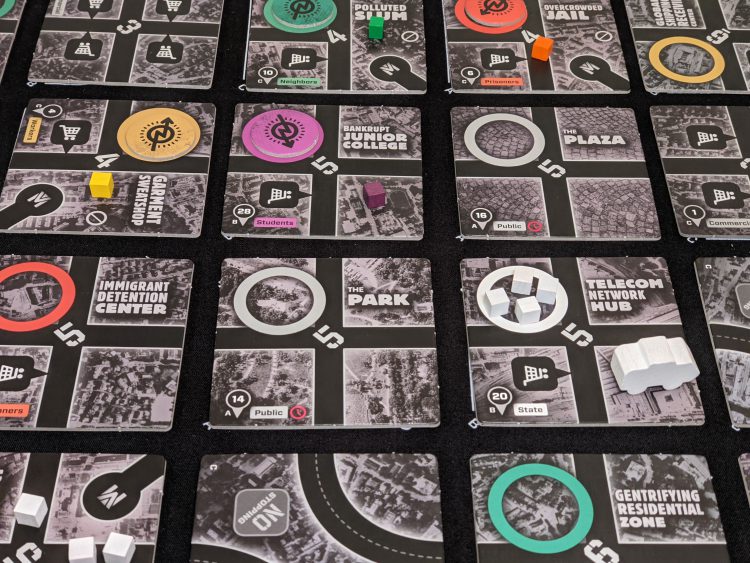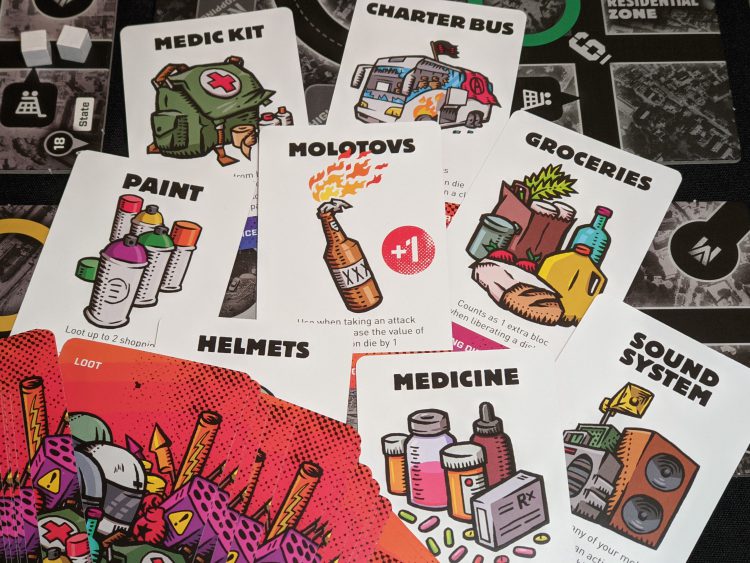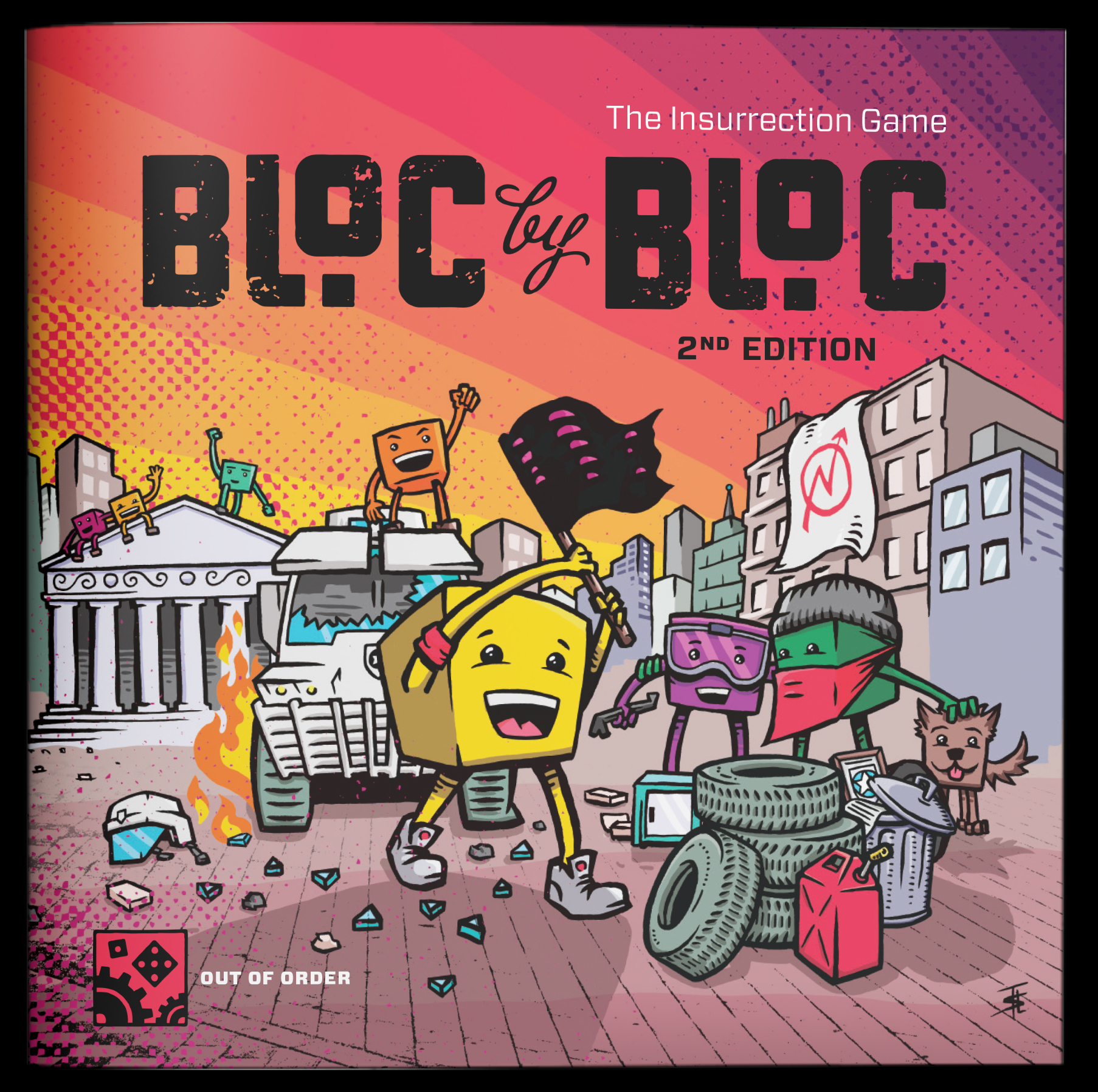In March 2020 as New York City entered lockdown I temporarily lost my sense of taste due to Covid-19. Three months later as protesters marched nightly through New York City’s blocks and boroughs, I temporarily lost my passion for board games.
Omar – June 2020
“At noon we marched north from Stonewall [Bar] to Herald Square, then back south to One World Trade Center and west to the Brooklyn Bridge. At 10PM we got word the cops were going to deploy [Long Range Acoustic Device] sound cannons so we decided to leave.
On our way to the subway five of us were followed by six cop cars and a NYPD van. They cut us off and at least 20 officers jumped out. They tackled one of us and braced the rest of us against the wall. They flexcuffed us and put us in the van and instead of taking us to holding a few blocks away they drove us across the Brooklyn Bridge into Brooklyn.
Ten of us waited in a 4’ by 8’ holding cell for hours. Forget social distancing; we couldn’t stand more than three inches apart. I was released after being issued a summons for violating curfew, even though we were detained earlier than the 11PM start time. As we left we passed a group of eight officers at the exit who jeered and made fun of us.
There were dozens of messages from family and friends on my phone. It was 3:30AM. I was held for more than six hours during which no one knew where I was or if I was alive. I wondered how to get home from Brooklyn to the Bronx without being arrested again – the subway was closed until 5AM and by being outside I was currently breaking curfew.”
My friends were among the thousands marching to honor Ahmaud Arbery, Breonna Taylor, George Floyd, and countless other Black victims of police-sanctioned violence and murder. To #saytheirnames. Night after night my friends masked-up and staved off burnout to stand toe-to-toe against a phalanx of interconnected and toxic injustices – including but not limited to systemic racism, white supremacy, police violence and brutality, the carceral state, disaster capitalism, anti-immigrant sentiment, and Donald Trump.
I didn’t join them on the front lines; due to slow Covid-19 recovery I hadn’t left my apartment for months. While they marched and made important noise I suffered fifty shades of guilt and impotence. Guilt for not being with them arm-in-arm and shoulder-to-shoulder, speaking truth to power and fighting for human rights. Guilt for not being able to do more, or enough, or seemingly anything that felt like it would help. And survivor’s guilt for having the dumb luck of a d6 roll to not have been a Covid casualty.
To play board games (or write about them) in this physical, mental, emotional, and spiritual context was impossible. It seemed nonsensical and profane to try. Words like “fun” and “escapist” looked wrong and sounded strange to say, as if misspelled. They were so blanched of meaning they morphed into alien abstractions.
I felt cravenly guilty pushing cubes and cards over cardboard while my activist friends were real-life superheroes in a city that had seen 20,000 deaths in three months. My heart was broken, and board games in my life were broken. And it wasn’t a fixable problem. It couldn’t be nerfed or house ruled or clarified by errata or a revised edition.
Over this backdrop, in this pandemic timeline, I played Bloc by Bloc: The Insurrection Game. It restored my faith in board games and why I play them.
Bloc by Bloc is a semi-to-fully cooperative game—designed by T.L. Simons—that recreates urban protest movements in recent world history. The game doesn’t reference specific events nor citizens from specific cities; it’s an allegorical insurrection set Anywhere (Population: You). Players are insurrectionists fighting to liberate their city one block at a time from a common enemy – the police, minions of the state that suffocate the city like Terminator units with the intent of neutralizing every last protestor.
“Bloc by Bloc” is not merely a clever game title; it contains multitudes. The city grid is made up of 25 randomly placed city district tiles. Many districts symbolize the inciting incidents (“Overcrowded Jail,” “Gentrified Residential Zone,” “Underfunded High School”) that led to uprising. Players choose factions (Neighbors, Workers, Prisoners, or Students) and are dealt unique agendas (winning conditions), then join forces to form a temporary coalition—or bloc—to save the city. Players deploy ten wooden faction cubes, where each cube represents a larger crowd of protestors and are referred to in-game as “blocs.”
Riot cops are cubes (blocks) and chunkier vehicles. There are far more police cubes than faction blocs by design; police presence is ubiquitous and their automatic movements always target and harass faction blocs. Cops are aggressive and stubborn and exponentially replenish. It’s also not insignificant that in this insurgent allegory, the riot cop pieces are white.

Players navigate the city to marshal friendlies and topple the state’s power centers. Every city tile has a strength value; the higher the value the more valuable that district is to the state. These attract more cops and are more difficult for players to breach. To occupy city tiles long enough to liberate them you either block (set up barricades and form in mobs to slow down police) or get blocked (overrun by riot cops and vans).
Games are played over ten nights (rounds) until reaching one of three endgame outcomes: two factions achieve their personal winning conditions; a faction is completely wiped out causing all players to lose, or a sunrise military intervention after Night #10 renders the city a lost cause and you as collateral damage.
Player strategy in Bloc by Bloc is a toolbox stripped down to bare essentials. Each night you will add one of your faction cubes to the board then roll your pool of dice. One die always represents one action, though the rolled value only sometimes matters. You take 3-5 actions depending on how many of your faction cubes are on the board. Since there’s a steady churn of blocs being removed by cops, available actions are precious and fickle.
Movement is a core tactic and the opposite of fiddly; one action die marches all your blocs in the same space as far as you want through the 5×5 city grid (honoring roadways and the edges of the board). Barricading is a thankless war of attrition. You place one barricade per die between city tiles (max of 3) to stiff-arm cop movements. However barricades are one-hit-and-done; building them is a vital yet Sisyphean task.
Looting requires an action die whose value meets or beats the strength of the city tile you’re looting and awards powerful Loot cards that pump up die rolls, increase your ranks, protect you in riots, or make it easier to liberate a city tile.

Occupying a city tile is a mandatory prerequisite to liberating it and is how you fulfill most winning conditions. You allocate an action die whose value meets or beats the city tile’s value, adding +1 for each faction cube you have there—solidarity and strength in numbers. Occupying tiles allow you to place an occupation token which both represents one unit of currency towards victory, and grants special powers such as loot cards or the ability to recruit faction cubes at a higher rate than one per round. However, occupy superpowers only last as long as you keep tile control over the virulent riot cops.
Logan – June 2020
“This was my first protest and first time breaking quarantine in twelve weeks. We started at Washington Square Park with thousands of people, peacefully chanting. We were offering free water bottles to people when a Black man on a bike (not part of the protest) passed us and voiced his support. Immediately cops swarmed him and violently shoved him off his bike. My friend ran forward to try to help the man and was thrown down by cops, pinned, and flexcuffed. I ran towards them but didn’t get far before another cop shoved me on top of an NYPD bike and pinned and cuffed me. This all happened in about a minute.
For three hours six of us were held inside a hot van in painfully tight flexcuffs. We were finally taken to Brooklyn and put in holding cells until 4:30AM (twelve hours later). While there one cop pointed at us saying “We’ll charge this one with assaulting an officer, and her with resisting arrest” (things that didn’t actually take place). I asked for a phone call and was told they “didn’t have phones.” I have so many bruises but got off easier than others. One woman had her arm visibly broken while the cops cuffed her and it was nearly an hour before cops called her an ambulance.”
No game with antagonistic police presence is complete without attack actions. Spending an action die with a value that meets or beats the city tile’s strength either removes one cop from the board or kicks two cops off your tile into an adjacent one. Riot vans are tougher; they can only be removed from play if attacked three separate times in the same night; partial damage only resets them to full strength.
A Police Ops phase follows each player’s turn. While protestors have a meager starter kit of actions and resources, the pre-programmed Police Ops machinations are absurdly harsh and as bitter as the dregs of a Dunkin Donuts coffee curdling in a Ford Interceptor. Police Ops cards punish you with random events and trigger riot cop activities such as propagation, locust swarms, and the cordoning of specific city tiles. There are no favorable Police Ops cards; at best you receive temporary reprieves from disaster.
The deck is further stacked against you due to Police Morale, which measures how many Police Ops cards (1-3) you must draw and resolve. Generally police morale only lowers when players attack to remove riot cops or riot vans. If you ignore an emboldened police force for too long, the Police Morale Track is a blunt assessment of how bad it gets.

When all players have taken a turn you enter the Sunrise phase. First, riot cops counterattack. Combat is a blunt instrument: if cops and protestors coexist on a city tile, one player cube is removed for each riot cop. Riot vans wipe out everything; all faction cubes are removed and occupied tiles are no longer considered occupied (losing their special power token).
After the dust settles from the police’s sunrise sweep, only then can you check for a city block’s liberation. To be liberated a city tile must be free of riot cops or riot vans, must have an Occupation token on it, and the combined total of blocs on the tile (from all factions) must meet or beat double the city tile’s value. This means you collectively must gather at least 8-12 protestor cubes on a single tile, hold the line, and survive a night of supernaturally aggressive policing to achieve 12% of your total victory objectives.
(Anonymous) – May 2020
“I saw a woman being beaten by cops. I jumped in. I was knocked down by one police officer who picked up a bicycle and rammed my body with it. I was beaten on the ground with batons by several other officers. Then I was arrested and put in a cell. No one was read their rights or given access to a phone call. I was lucky. I got out in just four hours.”
If Bloc by Bloc sounds difficult to win, it is. The game state is not neutral. The opposing sides are not equal. You have ten rounds to liberate at least 6-8 city tiles. You start with one of your ten faction cubes on one space in the city; cops start with 12 cops and four vans sprinkled all over. You start the game with three actions per turn so and everything you need to do is equally, urgently important.
Cops restrict your movement, and since each cop on a tile with your blocs automatically removes a cube it’s difficult to keep protestors on the streets. You also risk attracting cops if you take Loot or Occupy actions; on a d6 roll of 1-2 you summon a riot cop or draw a Police Ops card, which may irrevocably alter your turn. Even working cooperatively, you will make tradeoffs and sacrifices that hobble you.
Another disadvantage are the vagaries of luck – or in Bloc by Bloc, unluck. This isn’t chess and it isn’t perfect information. Die rolls determine what type of actions you take each turn. They determine whether you successfully occupy a city tile. They determine if police get called in while you loot or liberate. And the Police Ops card deck is unabashedly random; like playing a game of War or Fluxx with a straight face. Even your mini-successes will feel pyrrhic.

Bloc by Bloc is like a lot of modern co-ops. You grapple with the game itself, which runs through a set playlist on shuffle (random cards/dice) or repeat (“add X tokens to the board”) to determine obstacles, moves, and countermoves each turn. These automations are given thematic stand-ins: sandstorms in Forbidden Desert, a monster-of-the-week Nemesis in Aeon’s End; or a rash of global diseases in Pandemic. But sandstorms don’t have souls. Final bosses in mythical dungeons aren’t real. And a rash of pandemic outbreaks isn’t willfully cruel or nefarious, like a mustache-twirling Bond villain or a derelict politician.
Where Bloc by Bloc differs from other co-ops is that the “you-versus-the-game” dynamic is made real. You’re not power magic users or rock-star epidemiologists or fortune hunters. You’re you. And you’re not battling the boogeyman or a scientific mutation or a force of nature. You’re fighting the police state. They are nameless, faceless, and legion. They are uncaring. They are brutal. They are villainous. As you play Bloc by Bloc and they run up the score, it resonates. You take it personally. And the spoils aren’t as high-concept as “saving the world” or “escaping with the most treasure.” You’re winning back the soul of a city – your city – and protecting citizens’ human rights and welfare. Your human rights and welfare.
As we played Bloc by Bloc in June 2020 it took no leap of imagination to think of our friends as the in-game avatars while we pushed (their) wooden cubes through the cardboard city. When protestors or riot cops are removed from play, the rulebook uses the word “defeated.” I substituted more evocative and specific verbs as we played based on my friends’ eyewitness accounts. Kettled. Maced. Assaulted. Beaten. Flexcuffed. Arrested.
As we were crushed by bad dice rolls and awful card draws I thought of how Area Boardgamer™ might complain about Bloc by Bloc being too “swingy.” But the randomness here is intentional, because that’s how this world – our world – works. In Bloc by Bloc, asymmetrical is another word for inequality, and lack of control is a lived experience for many from marginalized and oppressed groups. In Bloc by Bloc having control is not divine right; it’s a triumph of the spirit.
As the game leaned into the low-humming dread and slow drip of hopelessness we saw a glimmer of what it might feel like to be a victim of injustice by those with the advantages of privilege and power. Whether it’s a game or real life, it’s demoralizing to see the bad guys get away with malice and murder, scot-free, over and over. Playing this game opened my apartment window to the world, and if I listened carefully enough I could hear my friends marching and chanting. I could persist. I could keep going. Because the winning condition—my hope, a city’s hope—was too important to abandon.

About hope: when a block is liberated in the game, you flip the city tile and reveal treasure underneath in the form of a Manifestation card. These grant big bonuses: more loot or faction cubes, or the power to remove riot cops from the board. Like their name suggests, Manifestation cards are unearthed rays of hope. It is yet another powerful metaphor: in Bloc by Bloc systemic inequality and oppression is part of game setup, but hope exists under every part of the city, waiting for those brave enough and strong enough to free it.
That’s why as challenging as Bloc by Bloc is to play, it’s worth every moment. Because it teaches collective hope in the face of the insurmountable. Even when falling short of victory you manifest unity and cooperation on the board and with your fellow players at the table. You experience empathy for and with your fellow players, and out there for people with causes and experiences beyond your own. You demonstrate that fomenting positive change to help the greater good is a winning strategy, and an essential life skill. Bloc by Bloc is a terrific game. It’s also a simulation – or tool – that helps connect (or reconnect) one’s inner beliefs and values to outward actions, in a way that is profoundly restorative.
(Anonymous) – June 2020
“We were kneeling. We were told to move. I began to back up. A police officer rammed me so hard in the ribs with his baton it knocked the wind out of me. I was then picked up off the ground by him or another officer (unsure, it all happened really fast) and literally thrown into a group of six officers. More baton beating. Then shoved face first into a metal barricade and handcuffed.
We were kneeling.
We only wanted to be heard.
We were KNEELING.
DO
NOT
GIVE
UP.
RESIST.”


